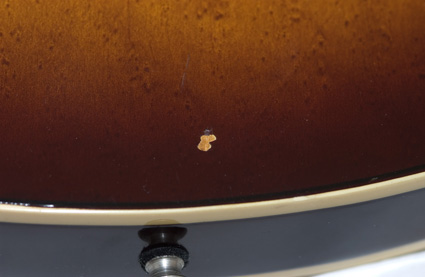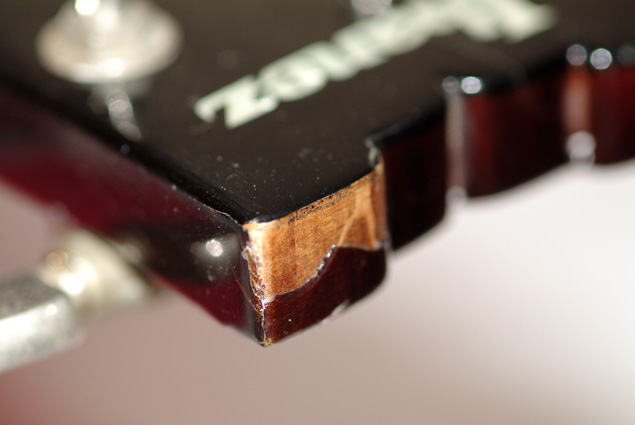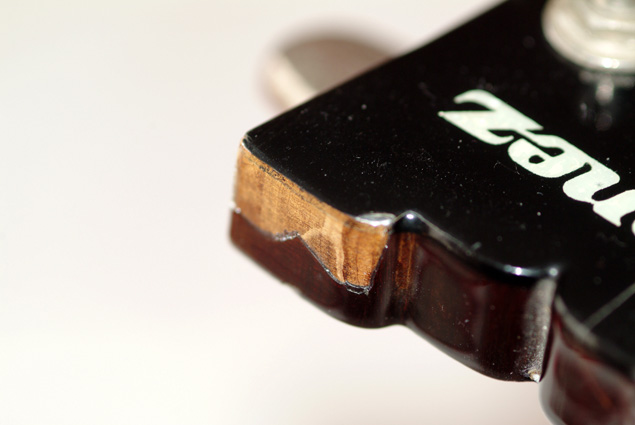| Author |
Message |
Dorigatti
Username: Dorigatti
Registered: 04-2005
| | Posted on Monday, May 02, 2005 - 6:58 pm: | |
Hi all,
I'm new here and recently acquired a very nice 1981 AS-50 in Violin Amber. There was no sound when I plugged it in, but all it needed some minor work on the electronics--a wire had cone off the input jack. BTW, I figured out a neat way to get the jack back in. I used one of those plastic drink straws with a bend in them. Just insert the bend end through the hole, thread it into the jack, secure it with small piece of tape, pull it back through and remove the tape. Very easy.
I also ordered Grover Rotomatics from Stewart-Macdonald as two of the original ones were falling apart.
It still needs minor finish work. In fact, I'm looking for advice on how to fix two small chips on the body finish, both in the dark-brown areas, as well as a 3 cm long chip along the top edge of the headstock (the wood shows). I heard Ibanez finishes do not respond to Gibson touch-up pens, so I'm looking for super glue in black and other colors that I can mix, but I haven't tracked down a local supplier. Any ideas of what to loook for?
I attach some pictures.
Thanks in advance for any input. This is a great site and Ibanez guitars are a revelation to me. In fact, Iím selling my PRS McCarty standard and looking for a Strat copy of some kind.
Iím a professional photographer (www.dorigatti.com) and Iíll post a pix of the finished AS-50 in a few days.
Carlo


 |
Johns
Username: Johns
Registered: 02-2001
| | Posted on Monday, May 02, 2005 - 7:43 pm: | |
Hey Jim, Spiro, and Jerry:
I'm also interested to hear what you master refinishers have to say about repairing these kinds of chips. The ones on the headstock are super common and can often be ignored, but the ones on the face of the guitar can really drive you nuts. |
Spiro
Username: Spiro
Registered: 02-2001
| | Posted on Monday, May 02, 2005 - 8:23 pm: | |
I would touch up the finish chip on the headstock for sure.. the one on the face of this guitar may be a little trickier but do able..
I dont know what other people use (most actually use super glue..) but I have found the best method being using the following items..
1 x epoxy resin (slow setting so as to mix the collour properly.)
1 x powdered dye (anilene or clothes dye) to the respective colours..
Various grades of sandpaper (wet and dry)
wood block (cork is too soft and will cause a mound)
polishing compound and cloths
I would mix the epoxy resin with the dye until I got a perfect colour match by testing on the actual guitar.. If it doesnt match I just wipe it away and start again.. This process only works with transparent finishes like above.
after you have matched the color Let it dry.. Dont try and build up the finish just yet.. Once the first coat has dried it is time to build up the finish with clear epoxy.. again let it dry for a few days before even attempting to sand it.. once it has hardened I would compound the finish until I am happy with the result..
The reason I dont use super glue is that it never looks right when polished.. the epoxy is nearly the same as the polyester finish and will blend quite well..
One thing you need to know is that the repair will chip the same as the existing finish around it...
For Nitro finishes it is a completely different kettle of fish.. |
Funkle
Username: Funkle
Registered: 12-2001
| | Posted on Tuesday, May 03, 2005 - 12:15 pm: | |
Thanks Spiro! I was wondering if there was a good way to fix those chips. I'll give it a try.
BTW, Spiro, I tried your polishing recipe (Meguiars Deep Crystal cleaner, Deep Crystal Polish followed by Mothers Carnuba wax) and had great results.
-Sven |
Dorigatti
Username: Dorigatti
Registered: 04-2005
| | Posted on Wednesday, May 04, 2005 - 11:12 pm: | |
Hi Spiro,
Thanks a lot for your invaluable information. I got the powdered dyes. The epoxy is being sent to me by a local company ó a small quantity for free because they like guitars (they usually sell the stuff in bulk to the Dutch boat industry. I live in Amsterdam, Holland).
BTW, how to I get a high gloss finish? I guess wet papering and compounding is like we used to use in the sixties on automobile paint jobs.
I have some rubbing compound that I bought in a local auto parts store. One can Nr 4 and one Nr 3, without silicones (whatever that means). I also have some US made Novus Plastic Polish Nr 3 (Prepares Acrylic Surfaces for Nr 2 polishing) and I also have the Novus Nr 2 (Scratch Remover). I also have some 000 steel-wool. Do I need anything else?
Why are Nitro finishes a different kettle of fish? Is the AS50 finish polyester? Whatís the difference?
ďOne thing you need to know is that the repair will chip the same as the existing finish around it..Ē Sorry, I donít understand, would you explain?
Fortunately the chip on the body is on the back of the guitar.
I am amazed how helpful you all are on this forum.
Carlo |
Spiro
Username: Spiro
Registered: 02-2001
| | Posted on Thursday, May 05, 2005 - 2:10 am: | |
Nitro finishes are repaired quite differently..
the burn in method (melt in some colour and then lacquer over it..
and the the whole refin over the top of the existing finish as the nitro lacquer melts with the application of new lacquer.. Polyester doesnt..
the crepair will chip as per the original finish ie. like glass!! |
Dorigatti
Username: Dorigatti
Registered: 04-2005
| | Posted on Thursday, May 05, 2005 - 7:58 pm: | |
Thanks Spiro for the update. When I'm finiahed I'll post a picturer of the (hopefully) decently repaired AS50. |
|
|
Thank you for supporting Ibanez Collectors Forum. Please help your favorite Ibanez guitar site as we endeavor to bring you the latest information about Ibanez custom vintage electric and acoustic guitars. Here you can discuss ibanez, guitars, ibanez guitars, basses, acoustics, acoustic, mandolins, electric guitar, electric bass, amplifiers, effect pedals, tuners, picks, pickups.
|


